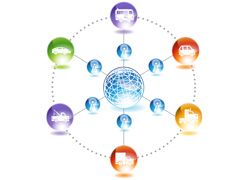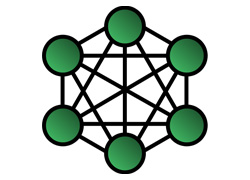IMDEA Networks

Archives: Events
Some combinatorial results initiated by application areas
In this self-contained talk I will describe few combinatorial results that were initiated by problems from several application areas. These results include the following: (1) the use of the Cycle Lemma in deriving statistics about several classes of trees (this includes, as a start, a very simple proof for the Catalan number of binary trees), (2) a new characterization of tree medians, (3) an algorithm for generation of permutations, (4) a result about the volume of discrete spheres, and (5) a combinatorial problem that resulted in a paper with
Paul Erdős
Enabling Technologies and Standards for Multi-hop Wireless Networking
The purpose of this seminar is to provide an introduction to state-of-art technologies and standards related to mobile multi-hop wireless networks, as broadly classified into three categories depending on their typical coverage: broadband wireless access (BWA), wireless local area networks (WLAN) and wireless personal area networks (WPAN).
Read more arrow_right_altTechnologies and Architecture of the Future Internet
The future Internet needs to provide enough flexibility to allow the dynamic deployment of new network protocols, support heterogeneous end-systems, provide novel communication abstractions, and exhibit inherent security and manageability. In this talk, I present an overview of various technological drivers that shape current developments in network architecture research. I will discuss how programmable routers and network virtualization provide the basis for adaptability in the network and present some of the related research problems. I will also provide an overview on ongoing research projects that aim to provide novel network architectures that may become the core of the future Internet.
Read more arrow_right_altObscure Giants: Detecting the Provider-Free ASes
We study the detection of the provider-free AS set (PFS), i.e., the set of those Autonomous Systems (ASes) that reach the entire Internet without paying anyone for the traffic delivery. Using trustworthy but non-verifiable sources for sanity checks, we derive the PFS from public datasets of inter-AS economic relationships. Whereas a straightforward method for extracting the PFS performs poorly because the datasets are noisy, we develop a more sophisticated Temporal Cone (TC) algorithm that relies on topological statistics and exploits the temporal diversity of the datasets. The evaluation shows that our TC algorithm detects the PFS with a high accuracy.
Read more arrow_right_altGoogle+ or Google-? Dissecting the Evolution of the New OSN in its First Year
In the era when Facebook and Twitter dominate the market for social media, Google has introduced Google+ (G+) and reported a significant growth in its size while others called it a ghost town. This begs the question that "whether G+ can really attract a significant number of connected and active users despite the dominance of Facebook and Twitter?".
Read more arrow_right_altMaking BGP filtering an habit: Impact on policies
It is common practice for network operators, usually for traffic engineering purposes, to propagate more specific prefixes (overlapping prefixes) along with shorter prefixes that cover them. On the other hand, it can be beneficial for some Autonomous Systems (ASes) to filter such overlapping prefixes.
Read more arrow_right_altDiscovering internet load balancing through reordering measurement
Speaker: Iljitsch van Beijnum, Research Assistant, Institute IMDEA Networks
Location: Room 4. 1F03, Telematics Department, Torres Quevedo Building, University Carlos III of Madrid, Avda. Universidad, 30, 28911 Leganes – Madrid
Date: May 25th 2011, 13:00
Organization: NETCOM Research Group (Telematics Department, University Carlos III of Madrid, Spain); Institute IMDEA Networks (Madrid, Spain)
The conference will be conducted in English
Read more arrow_right_altWhat is Spotify and how it works?
At Spotify we try to connect millions of people with their favorite music and build the best music service in the world. We believe that music should be easily accessible and than listening to music improves everybody lives. But achieving this goal is not easy and our team needs to face all kind of problems: from scalability issues to coordinate 200 engineers working together. One of our backend engineers will talk about how Spotify solves these issues from the moment you press Play.
Read more arrow_right_altMEDIEVAL: Project Plenary Meeting
Objectives of the meeting: Review status of the internal specifications milestones, synchronization intra and inter work packages and coordination for future work.
Read more arrow_right_altFLAVIA: Project Plenary Meeting
Wireless networks importance for the Future Internet is raising at a fast pace as mobile devices increasingly become its entry point. However, today's wireless networks are unable to rapidly adapt to evolving contexts and service needs due to their rigid architectural design. We believe that the wireless Internet's ability to keep up with innovation directly stems from its reliance on the traditional layer-based Internet abstraction. Especially, the Link Layer interface appears way too abstracted from the actual wireless access and coordination needs.FLAVIA fosters a paradigm shift towards the Future Wireless Internet: from pre-designed link services to programmable link processors.
Read more arrow_right_alt











Recent Comments